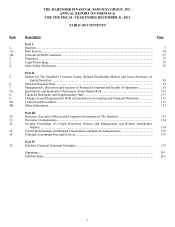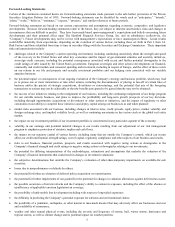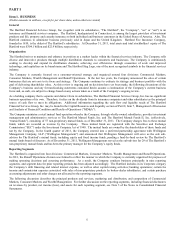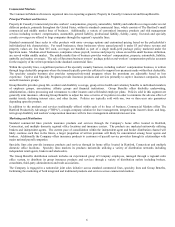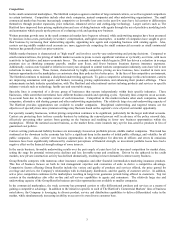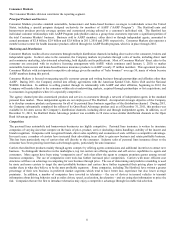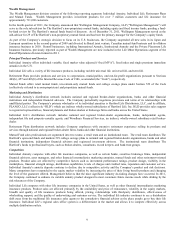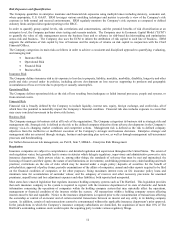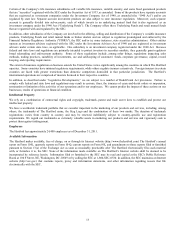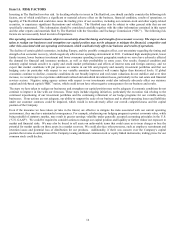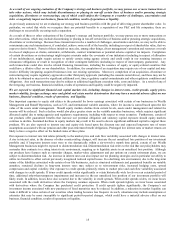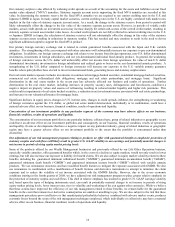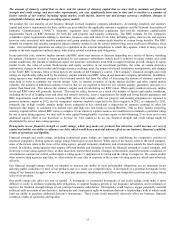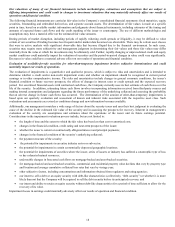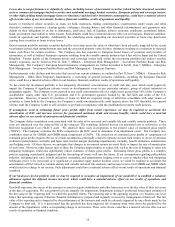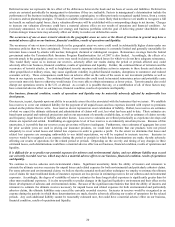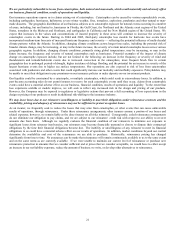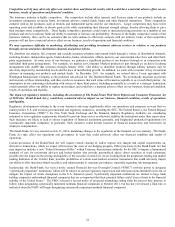The Hartford 2011 Annual Report Download - page 12
Download and view the complete annual report
Please find page 12 of the 2011 The Hartford annual report below. You can navigate through the pages in the report by either clicking on the pages listed below, or by using the keyword search tool below to find specific information within the annual report.
12
Risk Exposures and Quantification
The Company quantifies its enterprise insurance and financial risk exposures using multiple lenses including statutory, economic and,
where appropriate, U.S. GAAP. ERM leverages various modeling techniques and metrics to provide a view of the Company’ s risk
exposure in both normal and stressed environments. ERM regularly monitors the Company’ s risk exposure as compared to defined
statutory limits and provides regular reporting to the ERCC.
In order to quantify group capital levels, risk correlations and concentrations, and the potential benefits of risk diversification at an
enterprise level, the Company performs stress testing and scenario analysis. The Company uses its Economic Capital Model (“ECM”)
to quantify the value of risk management across the business lines and to advance its risk-based decision-making and optimization
across risk and business. The Company also uses the ECM to inform the attribution of risk capital to each line of business. ERM
supports the attribution of risk capital by line of business and the analysis of returns on risk capital in conjunction with the Chief
Financial Officer.
The Company categorizes its main risks as follows in order to achieve a consistent and disciplined approach to quantifying, evaluating,
and managing risk:
• Insurance Risk
• Operational Risk
• Financial Risk
• Business Risk
Insurance Risk
The Company defines insurance risk as its exposure to loss due to property, liability, mortality, morbidity, disability, longevity and other
perils and risks covered under its policies, including adverse development on loss reserves supporting its products and geographic
accumulations of loss over time due to property or casualty catastrophes.
Operational Risk
The Company defines operational risk as the risk of loss resulting from inadequate or failed internal processes, people and systems, or
from external events.
Financial Risk
Financial risk is broadly defined by the Company to include liquidity, interest rate, equity, foreign exchange, and credit risks, all of
which have the potential to materially impact the Company’ s financial condition. Financial risk also includes exposure to events that
may cause correlated movement in the above risk factors.
Business Risk
The Company manages its business risk at all levels of the organization. The Company categorizes its business risk as strategic risk and
management risk. Strategic risk is defined as the risk to the defined company objectives from adverse developments in the Company’ s
strategy vis-à-vis changing market conditions and competitor actions. Management risk is defined as the risk to defined company
objectives from the ineffective or inefficient execution of the Company’ s strategic and business decisions. Enterprise strategic and
management risks are assessed through strategic, business and operating plan reviews, as well as through management self-assessment
processes and benchmarking.
For further discussion on risk management, see Part II, Item 7, MD&A – Enterprise Risk Management.
Regulation
Insurance companies are subject to comprehensive and detailed regulation and supervision throughout the United States. The extent of
such regulation varies, but generally has its source in statutes which delegate regulatory, supervisory and administrative powers to state
insurance departments. Such powers relate to, among other things, the standards of solvency that must be met and maintained; the
licensing of insurers and their agents; the nature of and limitations on investments; establishing premium rates; claim handling and trade
practices; restrictions on the size of risks which may be insured under a single policy; deposits of securities for the benefit of
policyholders; approval of policy forms; periodic examinations of the affairs of companies; annual and other reports required to be filed
on the financial condition of companies or for other purposes; fixing maximum interest rates on life insurance policy loans and
minimum rates for accumulation of surrender values; and the adequacy of reserves and other necessary provisions for unearned
premiums, unpaid losses and loss adjustment expenses and other liabilities, both reported and unreported.
Most states have enacted legislation that regulates insurance holding company systems such as The Hartford. This legislation provides
that each insurance company in the system is required to register with the insurance department of its state of domicile and furnish
information concerning the operations of companies within the holding company system that may materially affect the operations,
management or financial condition of the insurers within the system. All transactions within a holding company system affecting
insurers must be fair and equitable. Notice to the insurance departments is required prior to the consummation of transactions affecting
the ownership or control of an insurer and of certain material transactions between an insurer and any entity in its holding company
system. In addition, certain of such transactions cannot be consummated without the applicable insurance department’ s prior approval.
In the jurisdictions in which the Company’ s insurance company subsidiaries are domiciled, the acquisition of more than 10% of The
Hartford’ s outstanding common stock would require the acquiring party to make various regulatory filings.


